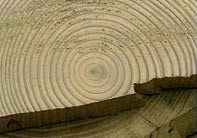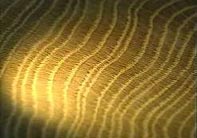
"Time flashes by. We are here for just a moment and then we’re part of history. My lifetime probably won’t last beyond 100 years if I’m lucky. But did you know that something we see nearly every day will far out live us. Not only that but it will see numerous of generations live and die - the tree.
 Trees have been growing on earth since before the human population arrived. This tree is 400 years old, which means that it survived not only the Great Plague which devastated the human population in the 17th Century, but also two World Wars and the 1987 hurricane!
Trees have been growing on earth since before the human population arrived. This tree is 400 years old, which means that it survived not only the Great Plague which devastated the human population in the 17th Century, but also two World Wars and the 1987 hurricane!
So much history is lost in the mists of time, but not for trees. Everything that has happened has actually been recorded inside. Trees are the ultimate precise annual calendar. By opening up a tree we can learn about the environment it grew in and conditions that may have affected the human population at the time.
But how is it possible to read the history from trees?

Every year a tree puts on a new layer of growth forming a ring just under the bark, it is that ring that tells us a year by year account of the events.
A wide ring means that it was a happy tree, with plenty of water and sunshine.
A narrow ring means that it was under a lot of stress, either from high winds or a very dry summer.
If the environment and conditions affected the trees that much, just think what it would have done to the human population!
But a living tree can only go back so far. To go back further we can look at wood which has been used as a building material. Almost every old building has wood in it, which retains the record of the tree’s life - those rings don’t disappear!
 By piecing together thousands of tree ring samples from around the world we can build a map of the environmental conditions going back thousands of years. This helps us to back up information that we already know about human life at that time.
By piecing together thousands of tree ring samples from around the world we can build a map of the environmental conditions going back thousands of years. This helps us to back up information that we already know about human life at that time.
These trees and their ancestors give us a new insight into thousands of years of our history."
If you’re interested in the scientific concepts behind everything from global warming to ecology and genetics, have a look at the introductory course S103 Discovering Science
And if you really want to go back to basics, explore the origins of the earth and life through course S269 Earth and Life
If you would like to know more about dendrochronology then here are a few suggestions to help you find out more:
Books you can read
’Tree Rings: Basic and Applications of Dendrochronology’, Fritz Hans Schweing Ruber, D.Reidel Pub. Co., ISBN 9027724458
’Methods of Dendrochronology: Applications in the Environmental Sciences’, E R Cook, Kluwer Academic Publishers, ISBN 0792305868
’Tree Rings, Environment and Humanity’, Jeffery S.Dean, Radio Carbon, ISBN 0963831429
Links you can surf
Information on time from ancient calendars to the atomic age
For more information on Cathy Groves and her research
If you want to know the time around the world!
Also on the Ever Wondered site:You can join Penny smith as she asks are we really living life 24-7? Or if you’ve always wanted to stop the march of time join Edward Enfield as he asks can we hold back time?
If you think you might be interested in studying more about these subjects, find out what the Open University has to offer.
The BBC and the Open University are not responsible for the content of external websites
Rate and Review
Rate this article
Review this article
Log into OpenLearn to leave reviews and join in the conversation.
Article reviews